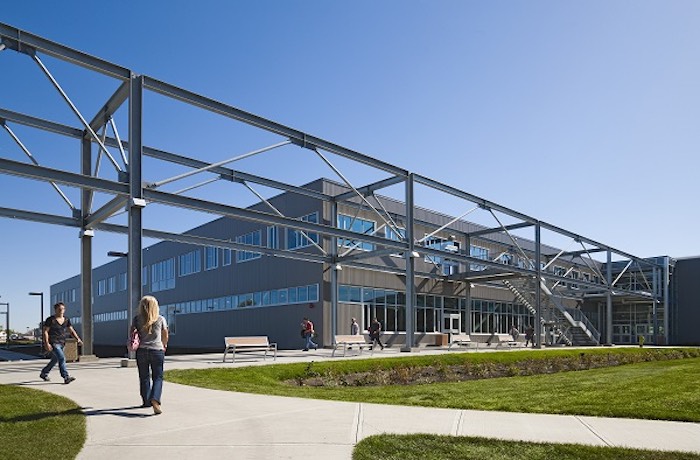Alberta
Province boosts apprenticeship programs adding room for more than 1,000 new students in Alberta

More apprenticeship spaces for Alberta students
Alberta is creating more than 1,000 new spaces for students in high-demand apprenticeship programs at post-secondary institutions.
Through Budget 2023, Alberta’s government is providing a funding boost of $15 million over three years to the Apprenticeship Learning Grants. With this increase, total funding for the grants will be $42 million in 2023-24.
The Apprenticeship Learning Grants are important for post-secondary institutions in Alberta that deliver classroom instruction to complement on-the-job training. New seats will be allocated to post-secondary institutions based on student demand and workforce data for in-demand skilled trades.
“This investment will help post-secondary institutions across Alberta create new spaces for students to build rewarding careers in the skilled trades. Strengthening our skilled labour force ensures that Alberta can respond to the needs of industry and the opportunities of our booming economy.”
“Apprenticeship education is an important part of our
post-secondary system. Making sure students have access to programs, training and resources not only sets them up for success but supports and grows industries and our economy with a world-class workforce.”
Alberta continues to diversify and grow, and as more people retire, the province is seeing an increased demand for skilled workers and apprenticeship learning opportunities. Student registration in Alberta’s apprenticeship programs increased to more than 15,600 in 2022 from 7,820 in 2020.
Each new seat created through this funding means more opportunities to connect students to
well-paying jobs while securing the talent Alberta needs to ensure the province remains competitive in a global economy.
“There is a growing need for skilled trade workers across Alberta. This announcement will provide support for new apprenticeships that will build Alberta’s economy.”
“Investment in post-secondary education is a key driver of Alberta’s economic prosperity. The expansion of apprenticeship seats ensures Red Deer Polytechnic can address the increased demand for skilled labour and trades training as Alberta industry and business continue to grow and prosper.”
“Alberta’s rebounding with opportunities for people in the skilled trades. I welcome this increase for post-secondaries to host classroom training for registered apprentices. For them, and especially for women in the trades, this financial support will change lives and keep Alberta growing.”
“Every new apprentice seat funded by this announcement supports a young Alberta family, builds community and strengthens the Alberta economy.”
Budget 2023 secures Alberta’s future by transforming the health-care system to meet people’s needs, supporting Albertans with the high cost of living, keeping our communities safe and driving the economy with more jobs, quality education and continued diversification.
Quick facts
- In the 2022-23 school year, 11 post-secondary institutions across Alberta are offering a combined total of about 22,000 seats in apprenticeship classroom instruction.
- The Government of Alberta offers apprenticeship education programs in 47 designated trades. Government administers and serves as the registrar, while post-secondary institutions deliver classroom instruction.
Alberta
Province says Alberta family doctors will be the best-paid and most patient-focused in the country

Dr. Shelley Duggan, president, Alberta Medical Association
New pay model, better access to family doctors |
Alberta’s government is implementing a new primary care physician compensation model to improve access to family physicians across the province.
Alberta’s government recognizes that family physicians are fundamental to strengthening the health care system. Unfortunately, too many Albertans do not currently have access to regular primary care from a family physician. This is why, last year, the government entered into a memorandum of understanding with the Alberta Medical Association (AMA) and committed to developing a new primary care physician compensation model.
Alberta’s government will now be implementing a new compensation model for family doctors to ensure they continue practising in the province and to attract more doctors to choose Alberta, which will also alleviate pressures in other areas of the health care system.
This new model will make Alberta’s family doctors the strongest-paid and most patient-focused in the country.
“Albertans must be able to access a primary care provider. We’ve been working hard with our partners at the Alberta Medical Association to develop a compensation model that will not only support Alberta’s doctors but also improve Albertans’ access to physicians. Ultimately, our deal will make Alberta an even more attractive place to practise family medicine.”
“We have worked with the Alberta Medical Association to address the challenges that primary care physicians are facing. This model will provide the supports physicians need and improve patient access to the care they need.”
The new model is structured to encourage physicians to grow the number of patients they care for and encourage full-time practice. Incentives include increases for:
- Maintaining high panel numbers (minimum of 500 patients), which will incentivize panel growth and improve access to primary care for patients.
- Providing after-hours care to relieve pressure on emergency departments and urgent care centres.
- Improving technology to encourage using tools that help streamline work and enhance patient care.
- Enhancing team-based care, which will encourage developing integrated teams that may include family physicians, nurse practitioners, registered nurses, dietitians and pharmacists to provide patients with the best care possible.
- Adding efficiencies in clinical operations to simplify processes for both patients and health care providers.
As a market and evidence-based model, it recognizes and pays for the critically important work of physicians, including the number of patients seen and patient complexity, as well as time spent providing direct and indirect care.
“Family medicine is the foundation of our health care system. This model recognizes the extensive training, experience and leadership of primary care physicians, and we hope it will help Alberta to attract and retain more family medicine specialists who provide comprehensive care.”
Additionally, family physicians who are not compensated through the traditional fee-for-service model will now receive higher pay rates under their payment model, known as the alternative relationship plan. This includes those who provide inpatient care in hospitals and rural generalists. Alberta’s government is increasing this to ensure hospital-based family physicians and rural generalists also receive fair, competitive pay that reflects the importance of these roles.
“This new compensation model will make Alberta more attractive for physicians and will make sure more Albertans can have improved access to a primary care provider no matter where they live. It will also help support efforts to strengthen primary care in Alberta as the foundation of the health care system.”
“Family physicians have been anxiously awaiting this announcement about the new compensation model. We anticipate this model will allow many primary care physicians to continue to deliver comprehensive, lifelong care to their patients while keeping their community clinics viable.”
Quick facts
- Enrolment in the primary care physician compensation model will begin in January with full implementation in spring 2025, provided there are at least 500 physicians enrolled.
- The alternative relationship plan rate has not been updated since it was initially calculated in 2002.
- The new compensation model for family doctors is the latest primary health care improvement following actions that include:
- A $42-million investment to recruit more health providers and expand essential services.
- A new rural and remote bursary program for family medicine resident physicians.
- Additional funding of $257 million to stabilize primary care delivery and improve access to family physicians.
- Implementing the Nurse Practitioner Primary Care Program, which expands the role of nurse practitioners by allowing them to practise comprehensive patient care autonomously, either by operating their own practices or working independently within existing primary care settings.
Related information
Alberta
Federal taxes increasing for Albertans in 2025: Report

From the Canadian Taxpayers Federation
By Kris Sims
The Canadian Taxpayers Federation released its annual New Year’s Tax Changes report today to highlight major tax changes in 2025.
The key provincial tax change expected for Alberta is a reduction in the income tax rate.
“The Alberta government promised to reduce our lowest income tax bracket from 10 down to eight per cent and we expect the government to keep that promise in the new year,” said Kris Sims, CTF Alberta Director. “The United Conservatives said this provincial income tax cut would save families about $1,500 each and Alberta families need that kind of tax relief right now.
“Premier Danielle Smith promised to cut taxes and Albertans expect her to deliver.”
Albertans will see several federal tax hikes coming from Ottawa in 2025.
Payroll taxes: The federal government is raising the mandatory Canada Pension Plan and Employment Insurance contributions in 2025. These payroll tax increases will cost a worker up to an additional $403 next year.
Federal payroll taxes (CPP and EI tax) will cost a worker making $81,200 or more $5,507 in 2025. Their employer will also be forced to pay $5,938.
Carbon tax: The federal carbon tax is increasing to about 21 cents per litre of gasoline, 25 cents per litre of diesel and 18 cents per cubic metre of natural gas on April 1. The carbon tax will cost the average household between $133 and $477 in 2025-26, even after the rebates, according to the Parliamentary Budget Officer.
Alcohol taxes: Federal alcohol taxes will increase by two per cent on April 1. This alcohol tax hike will cost taxpayers $40.9 million in 2025-26, according to Beer Canada.
Following Budget 2024, the federal government also increased capital gains taxes and imposed a digital services tax and an online streaming tax.
Temporary Sales Tax Holiday: The federal government announced a two month sales tax holiday on certain items like pre-made groceries, children’s clothing, drinks and snacks. The holiday will last until Feb. 15, 2025, and could save taxpayers $2.7 billion.
“In 2025, the Trudeau government will yet again take more money out of Canadians’ pockets with payroll tax hikes and will make life more expensive by raising carbon taxes and alcohol taxes,” said Franco Terrazzano, CTF Federal Director. “Prime Minister Justin Trudeau should drop his plans to take more money out of Canadians’ pockets and deliver serious tax relief.”
You can find the CTF’s New Year’s Tax Changes report HERE.
-

 Brownstone Institute2 days ago
Brownstone Institute2 days agoA Potpourri of the World’s Unexposed Scandals
-

 COVID-192 days ago
COVID-192 days agoEsteemed UK Doctor pleads with governments to cancel COVID-19 vaccines
-

 National1 day ago
National1 day agoPaul Wells: The Second Finance Ministers Club
-

 Bruce Dowbiggin2 days ago
Bruce Dowbiggin2 days agoMLB’s Exploding Chequebook: Parity Is Now For Suckers
-

 Business2 days ago
Business2 days agoEXCLUSIVE: Former Biden Climate Czar Apparently Pushed Homeland Security To Ease Up On Chinese Company Linked To Slave Labor
-

 Business1 day ago
Business1 day agoOut-Trumping Trump: A Mission Without a Win
-

 conflict1 day ago
conflict1 day agoSending arms to Ukraine is unnecessarily placing American lives in danger
-

 Business1 day ago
Business1 day agoThe CBC gets $1.4 billion per year, but the Trudeau government wants to give it more






